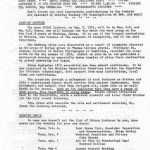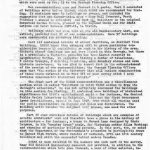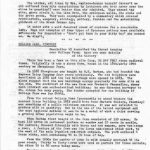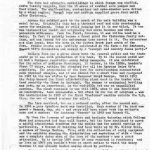Newsletter
Page 1
STOP PRESS **** DON’T FORGET THE CHRISTMAS PARTY **** FRIDAY DECEMBER 6 AT 166 STATION ROAD, NW4 **** STARTS 7.30 P.M. **** TICKETS 75p ADULTS, 50p UNDER-14S **** REFRESHMENTS INCLUDED ****
Don’t forget too that last-minute contributions to the Tombola are welcomed by Dorothy Newbury.
January Lecture
The next HADAS lecture, on 7 January 1975 will be by Mrs. M. U. and Mr. W. T. Jones, who will discuss the dig which has been going on for the last nine years at Mucking, Essex. It is one of the largest excavations in Britain, and because of the sequence of occupation, one of the most important.
The Mucking sites were discovered as a result of cropmarks observed in 50 acres of barley grown on Thames terrace gravel. Professor St. Joseph, Director of Aerial Photography at Cambridge, recorded the cropmarks in the dry summer of 1959. Almost as soon as he had published a photograph showing an especially dense complex of sites their destruction by gravel quarrying had begun.
Since September 1965 excavation has been almost continuous. It is now organised by the Mucking Excavation Committee (within the Committee for Thurrock Archaeology), with support from many institutions, local firms and individuals.
The cropmarks provide a palimpsest of such features as ditches and pits — underground traces which survive from ancient landscapes. When plough soil and sub soil has been stripped of, these should show up as soil marks in the gravel. Work so far indicates that they have a range of 3,000 years, from Neolithic to early Saxon. Flints extend occupation back to the Mesolithic, while a medieval windmill and later field ditches are the only recent features.
Mrs. Jones will describe the site and settlement material, Mr Jones the cemetery material.
Looking Ahead
In case you haven’t got the list of future lectures by you, here again of the details for your new diary:
Tuesday Feb. 4 – The Lunt Roman Fort, Warwicks – Excavation and reconstruction – Brian Hobley
Tuesday March 4 – Medieval Jewellery and Pottery – John Cherry
Tuesday April 1 – Are We Fair to Neanderthal Man? – Desmond Collins
Tuesday May 6 – Annual General Meeting
All meetings take place at Central Library, The Burroughs, NW4 and start at 8.00p.m. with coffee and biscuits.
HADAS Building Survey
The Society survey of buildings which might be included in the revised Statutory List of Buildings of Architectural and Historic Interest has now been completed.
Page 2
As described in newsletters 41 and 42, this survey began as a result of an invitation from the Borough Planning Officer to put forward recommendations which he, in turn, could place before the officers now conducting, for the Department of the Environment, a revision of the Statutory List for our Borough. Some 25 members volunteered to help with the survey. The Borough was sub-divided into eighteen areas; during the last three months each volunteer has studied the buildings in his or her area.
When these studies were completed, the Research Committee took over. It went into fairly continuous session, sifting all the information provided by the volunteers and working out the final recommendations, which were sent on 13 November to the Borough Planning Office.
Our recommendations were put forward in 4 parts. Part I consisted of buildings never before Listed, which HADAS now recommended for Listing. It contained some 43 buildings or groups, and included the suggestion that one Conservation Area – Moss Hall Crescent, North Finchley — should be extended; and that all buildings in the original Hampstead Garden Suburb, planned by Sir Raymond Unwin and Sir Edwin Lutyens and built between 1907-14, be Listed.
Buildings which had once been on the old Supplementary List, now extinct, provided Part II of our recommendations. Here 57 buildings were recommended for statutory Listing.
Part III contained the details of street furniture, as distinct from buildings. HADAS hopes this category will be given particular consideration because it contributes so much to the history of the area. Hitherto street furniture has not been Listed in this Borough, but there is a precedent — a Victorian post-box has been Listed recently in neighbouring Camden. We suggested Listing a number of milestones, 6 cattle troughs, 2 drinking fountains, some boundary stones and some historic post-boxes. We are glad to report that in his acknowledgement of the receipt of our recommendations, the Borough Planning Officer says that “the review of the Statutory List will include consideration of those items referred to in Part III of your survey which I noted includes considerable historical detail”.
The final part of the HADAS recommendations was a miscellaneous section which we called “buildings to which HADAS wishes to draw the Borough’s attention”. We did not definitely recommend the buildings in this section for Listing. It contained some buildings of historical significance but a little architectural merit — for instance, the Central Public Health Laboratory in Colindale. This was the first Government Lymph Establishment, opened in June 1907, from which all vaccine used for public vaccinations in England and Wales was distributed. The building still retains the original calf houses, now used for other purposes.
Part IV also contained details of buildings which are examples of notable architects’ work and therefore have a place in the history of architecture — for instance, a house in Barnet Lane designed by Edwin Lutyens, in his “country house” style, for Victorian author Silas Hocking; and examples of particular building periods. In this part, too, we are asked that the Department of the Environment’s attention be particularly drawn to Barnet High Street, where remains of Medieval, seventeenth and eighteenth century buildings may still lie concealed behind modern facades.
HADAS is much indebted to the members who took part in the survey. Many did detailed documentary research and provided, in addition to the recommendations which have gone forward, a mass of other material, including photographs, of interesting buildings all over the Borough. All this information will be incorporated in the Society’s Buildings Index, making it a larger and more effective source of reference.
Mycenae Rich in Gold
Raymond Lowe reports on the November 5th lecture.
Having been asked to forego the pleasures of Guy Fawkes, which always smacks of a pre-Christian Nordi religious ritual, we were well rewarded by Mrs. Wallace-Zeuner. Seldom have so many members (a record 104) been so entertained and informed in such a delightful manner.
Page 3
We were first shown two replicas of the famous Vapheio gold cups with their scenes of bulls and athletes. They were passed round the room while we were skilfully led to through the legend and history of the city and the Trojan War, a story which, if it were contemporary, would find its place in the News of the World.
The various folk movements which affected the Minoan and Mycenean empires were briefly touched on and the history of the digs which began with Heinrich Schliemann, one of the fathers of archaeology, and now continues with the work of Lord William Taylour. All this was given in a very lively manner. The slides, all taken on by Mrs. Wallace-Zeuner (haven’t we all suffered from site descriptions by lecturers who have never seen the sites in question?) were better than she admitted. They showed the site, grave circle A, the Lion Gate, the cyclopean walls, the stele and the grave goods. They were accompanied by a commentary which covered architecture, weaponry, strategy, pottery, fashion and the astonishing gold work of the Greek Bronze Age.
It ended with a well-deserved round of applause for a remarkable lady. Maps and examples of four types of Mycenean pottery were available afterwards for inspection — “don’t put them the your ditty bag” she warned us. We didn’t.
College Farm, Finchley
Newsletter 45 described the threat hanging over College Farm; here are some details of its history.
There has been a farm on this site (app. TQ 247 895) since medieval times. Originally it was a sheep farm, known in the 18th/early nineteenth century as Sheephouse Farm.
In 1868 Sheephouse was bought by G. T. Barham, who had founded the Express Dairy Company four years previously. The old buildings were demolished in 1882 and the new buildings were opened in 1883. The plans suggest that the new buildings occupy precisely the same site as the old. The architect of the new farm was Frederick Chancellor, whose main interest was ecclesiastical building; he was diocesan surveyor to St. Albans for many years. The tender accepted for the building of college farm was for £4942.
From the outset College Farm (presumably so named because the nearest large building in 1883 would have been Christ’s College, Finchley) was something of a public relations exercise. It was not intended to produce milk in quantity; but in its use of the latest equipment and the most hygienic methods it was to be a model of what a dairy serving a growing urban population ought to be.
When Barham first bought it, the farm consisted of 120 acres. He kept 110 acres in permanent pasture or meadow and 10 acres in arable. The pasture, dressed liberally with horse and cow manure, gave two crops a year. A feature of the farm was its large oak-fenced stack yard, to the east of the main 5-gable red-brick complex. The yard enclosed 6 large ricks, each containing 40 to 50 tons of hay.
From the 1890s, the number of cows in a milk usually averaged 40 the year round. 30-40 acres were used as pasture for these animals, the other 70-80 acres being mown.
Precise records and accounting were one of the rules. In 1890 the Farm produced 28,184 gallons of milk, from a herd composed half of Guernseys and half of Shorthorns and Kerrys. As cows went dry they were retired to another Express farm and replaced by newly calved cows. The average yield per cow was about 587 gallons. The money value of each cow’s milk at 4d a quart was approximately £37 for 10 months in milk.
The farm had its own laboratory, on one side of the entrance hall. The office was on the other side. In the upper part of the building were dormitories for the men. The main part of the building consisted of the byre and a large milking parlour, the walls of which were Minton-tiled.
Page 4
The name of each cow appeared on its stall along with the cards and rosettes it had won at shows.
Later the east end of the building was adapted for use by the ponies which drew the milk floats. Another Express Dairy Farm at nearby Fryth was also used for Welsh ponies. Pony-drawn floats were finally taken out of service in 1957. The last pony, aged 20, died in 1972. The year before he had appeared, by special invitation, at the Horse of the Year Show, accompanied by the last of the Dairy’s team of ten farriers, then aged 95.
The farm had extensive outbuildings in which forage was chaffed, roots (mainly mangels, from the 10 acres of arable) were pulped and food mixed. The chaff-cutter, root-pulper and cake-crusher were driven by a steam engine. Mangel tops and cabbage supplied green food until after Christmas.
Across the cobbled yard to the south of the main building was a model dairy. Originally this had a thatched roof and a wide overhanging eaves for coolness. Today it still remains but it is now tiled. It too was Minton-tiled inside and originally had slate benches and white porcelain milk-pans. From the first, however, it was little used as a dairy. In fact it quickly became a focal point for Victorian family outings, and was famous for the watercress teas served in it. The watercress was also local, from the beds in the Mutton Brook just south of the farm. Public events were publicly celebrated at the farm — for instance, Edward VII’s Coronation was marked by a “crumpet and country dance party”.
College Farm was a place where both the general public and the trade could go to see milk production at its best. Up to the Second World War it had a European reputation among the dairy managers. It was celebrated for its sales of pedigree Guernseys; it became, in the 1920s, London’s first TT dairy, setting the standard for all the Express Dairy Company’s suppliers. The preparation of the farm for certification necessitated some physical changes, and it was closed for a short time and reopened in 1921 in its new status by Dame Margaret Lloyd George. Until 1963 the dairy housed the first milk-bottling plant used in the London area (and possibly the first in Britain). The change to mechanical bottling was made, as an experiment, in the mid-1920s and was an unqualified success. The plant remained in use till 1963, when it was demolished as uneconomic. Less successful — but still in the van of progress — was the installation in 1929 of the first “Sealcone” machine outside the U.S. (i.e. the use of waxed cartons for milk).
The farm survived, but on a reduced scale, after the second war. In 1946 a pure Ayrshire herd was installed. Each member of the herd was named – Hannah, May, etc — and every calf born since took his mother’s name and a number; for instance “Hannah” in 1972 was Hannah 45.
By then the lessons of up-to-date and hygienic dairying which College Farm had pioneered had been well learnt, but the farm continued to serve a useful educational function for the public and for school parties in particular. A Museum of Dairying had been built up by Mr Walter Nell, a nephew of George Barham. This, with its collection of early equipment and its exhibits showing the distribution and marketing of milk — there was a complete dairy shop of the turn-of-the-century — was a great attraction. Up to Spring 1974 some 10 cows remained in residence; and as late as 1973 you couldn’t book at short notice to visit the dairy because it was already booked months ahead by parties.
Where now for College Farm? The departure of the cows last spring and the more recent dismantling of the museum and its local treasures have broken one of the last remaining links with Finchley’s rural past. What will replace, in the dairy buildings and the fields around them, those contentedly chewing beasts which brought life back into perspective for many a tired commuter returning home from a day in the rat-race? We wish we knew the answer — but at the moment the whole subject seems to be shrouded in silence.





